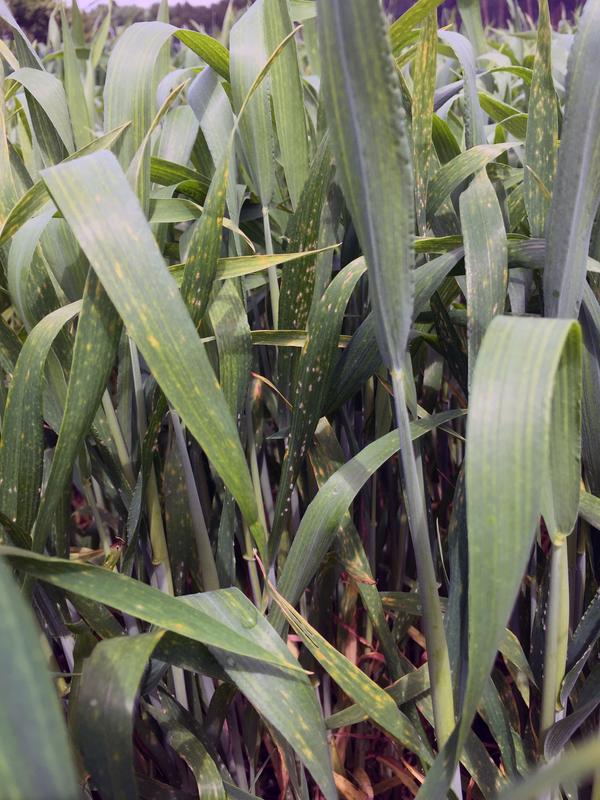Combination of Resistance Genes Offers Better Protection for Wheat against Powdery Mildew

Wheat line without Pm3 alleles, infected by powdery mildew UZH
A decent wheat harvest requires robust wheat. However, wheat crops are often infected by fungal diseases such as powdery mildew. For several years now, UZH researchers have been investigating a wheat gene that confers resistance to powdery mildew (Blumeria graminis f. sp. tritici).
The gene, called the Pm3 resistance gene, exists in different variations, so called alleles. In previous studies, plant researcher Beat Keller and his team demonstrated that single Pm3 alleles are able to confer resistance against powdery mildew fungi.
And yet, a single resistance gene can quickly lose its effectiveness. Thus when it comes to plant breeding, it is important to combine multiple resistance genes. This is exactly what researchers at UZH have now tested in field trials using transgenic wheat lines.
Combination of two Pm3 variations increases powdery mildew resistance
The researchers created new wheat lines by crossbreeding transgenic Pm3 lines (see box). This resulted in four new wheat lines, each containing two different Pm3 gene variations. “These four new wheat lines showed improved resistance against powdery mildew in field trials compared with their parental lines – during the field seasons 2015 to 2017,” explains Teresa Koller, lead author of the study.
No negative effects on wheat yield
Back in the laboratory, the scientists proved that the parental lines’ gene activity is added up in the newly created lines. Each Pm3 allele in the four new lines displayed the same activity as in the parental line, which results in increased overall activity, since it came from two different gene variations. “The improved resistance against powdery mildew is the result of the increased total transgene activity as well as the combination of the two Pm3 gene variations,” summarizes Teresa Koller. The high overall activity of resistance genes did not cause any negative effects for the development of the wheat or its yield.
Application in modern wheat breeding
The findings of these trials improve our general knowledge of the immune system of plants, and in particular of fungal disease resistance of wheat. Besides contributing to fundamental research in the area of plants’ immune systems, the findings can also be applied in wheat breeding. Thanks to the precise testing of Pm3 alleles, the best variations and combinations are identified and can then be used directly in traditional breeding by crossbreeding them into modern wheat varieties.
Literature:
Teresa Koller, Susanne Brunner, Gerhard Herren, Severine Hurni, and Beat Keller. Pyramiding of transgenic Pm3 alleles in wheat results in improved powdery mildew resistance in the field. Theoretical and Applied Genetics. January 11, 2018. DOI: 10.1007/s00122-017-3043-9
Function of the Pm3 resistance gene
The Pm3 gene is the “blueprint” for a protein that can receive signals in the plant cell, i.e. a receptor. It is able to recognize avirulent proteins, or AvrPm3 for short, of the powdery mildew fungus. The receptor triggers the plant cell’s death as soon as the harmful fungus attempts to inject the AvrPm3 protein into the plant cell. By killing off the attacked cell, the rest of the plant is protected against the fungus. Different Pm3 gene variations, or Pm3 alleles, encode different variations of the receptor. These receptor variations are able to recognize different AvrPm3 proteins of the powdery mildew fungus.
Previous studies
Prof. Beat Keller and his team have identified various Pm3 gene variations in powdery mildew-resistant wheat varieties from across the world. To assess the function and effectiveness of the different Pm3 gene variations, they were genetically engineered into the genome of the spring wheat variety Bobwhite. Bobwhite wheat lacks its own functioning Pm3 gene and is very susceptible to powdery mildew. The transgenic Bobwhite wheat lines, each containing a single Pm3 gene variation, were assessed in field trials as part of the National Research Program NFP59 between 2008 and 2010. The findings of these trials were published in 2011 and 2012.
Contact:
Prof. Beat Keller
Department of Plant and Microbial Biology
University of Zurich
Phone +41 44 634 82 30
E-mail: bkeller@botinst.uzh.ch
http://www.media.uzh.ch/en/Press-Releases/2018/transgenic-wheat.html
Media Contact
All latest news from the category: Agricultural and Forestry Science
Newest articles

A ‘language’ for ML models to predict nanopore properties
A large number of 2D materials like graphene can have nanopores – small holes formed by missing atoms through which foreign substances can pass. The properties of these nanopores dictate many…

Clinically validated, wearable ultrasound patch
… for continuous blood pressure monitoring. A team of researchers at the University of California San Diego has developed a new and improved wearable ultrasound patch for continuous and noninvasive…

A new puzzle piece for string theory research
Dr. Ksenia Fedosova from the Cluster of Excellence Mathematics Münster, along with an international research team, has proven a conjecture in string theory that physicists had proposed regarding certain equations….



